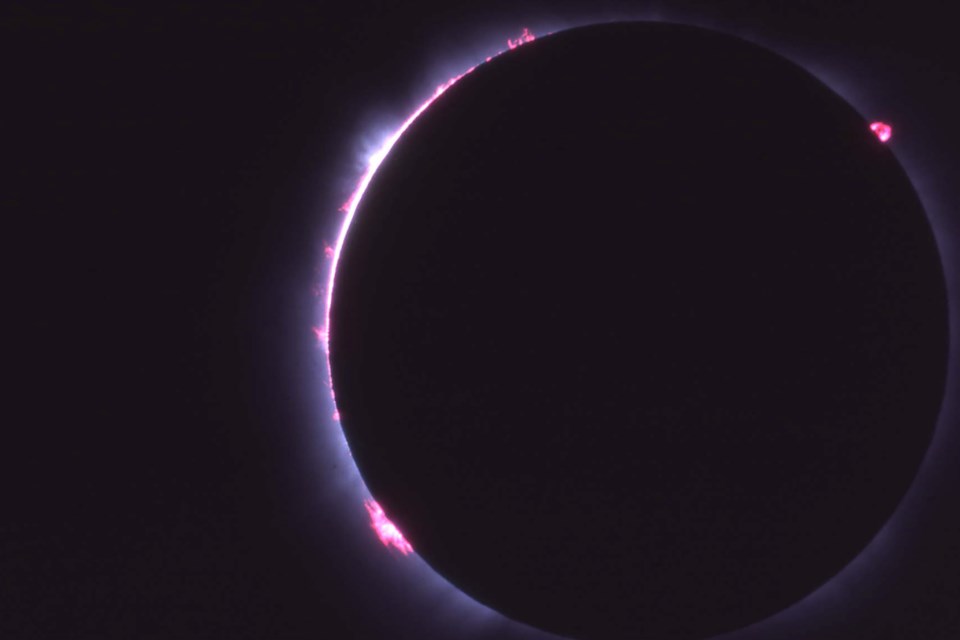NEWS RELEASE
BROCK UNIVERSITY
***************************
The one-year countdown is on until people in Niagara can experience a rare astronomical phenomenon that, for many, happens only once in a lifetime.
On April 8, 2024, a total solar eclipse will take place over southern Ontario, with the moon passing between the Earth and the sun, obscuring the sun completely for a short period of time.
“The Earth, moon and sun all align, so what you'll see is the shadow of the moon,” said Barak Shoshany, Brock University assistant professor of physics and member of the Ontario Eclipse Task Force. “The moon blocks light from the sun and casts a shadow, but only on a particular area of the planet’s surface.”
A total solar eclipse takes place roughly every 18 months, but it doesn't often happen close to Niagara. The last time a total solar eclipse occurred over Ontario was in 1979, and the next one won’t happen again over the province until 2099.
"It’s a very rare thing to see. Usually, people have to travel to the other side of the planet if they want to see a total solar eclipse,” Shoshany said. “But next year, we will have a chance to see it right here at Brock University and in our province.”
The Niagara region will be in the eclipse’s ‘path of totality,’ or the path of the moon’s umbra, which is the innermost and darkest part of the moon’s shadow.
“As the Earth rotates, and as the moon moves around the Earth, the shadow of the moon traces a path over the planet,” Shoshany said. “If you happen to be inside the shadow of the moon, you will see an eclipse. If you’re right in the middle of it, along the ‘path of totality,’ you will see a total eclipse.”
St. Catharines will experience a total solar eclipse on Monday, April 8, 2024, from 3:18:15 p.m. to 3:21:30 p.m. The maximum eclipse, when the moon is closest to the centre of the sun, will take place at 3:19:53 p.m.
According to an online eclipse map, the total eclipse can be observed in Ontario only within a narrow band along the U.S. border, all the way up to Hamilton, Brantford and Burlington. Kingsville will be one of the most western and earliest points to see the total eclipse, starting at 3:13:42 p.m. and lasting until 3:15:28 p.m. As the moon moves along its orbit, the path of totality will move north and east.
“Every second counts when it comes to observing the eclipse,” Shoshany said. “Three minutes of totality is a short window to cherish this rare, breathtaking view. Mark your calendars now and plan to be in Niagara on April 8. You don’t want to miss this.”
While Shoshany has seen partial eclipses, he has never seen a total solar eclipse and is excited to witness one for the first time. As a theoretical physicist and teacher of astronomy, he is particularly interested in eclipses because of the role the total solar eclipse of 1919 played in confirming Albert Einstein's then-four-year-old theory of general relativity.
“According to Einstein’s theory, massive objects cause spacetime to bend and curve. We interpret this curvature as gravity because it deflects the path of objects passing through space toward the massive object,” he said. “Light also gets deflected in the same way, so Einstein predicted that stars will appear to change their position when their light passes near the sun."
Normally, the brightness of the sun makes it impossible to see the stars in the daytime, but with a total solar eclipse, stars can be seen near the sun with a telescope.
“Two expeditions of astronomers, organized by Dyson and Eddington, were able to photograph the stars near the sun and concluded that they had indeed been deflected by the curvature of spacetime,” Shoshany said. "This amazing discovery appeared on the front pages of newspapers around the world and made Einstein and his theory famous."
To observe the 2024 eclipse safely, Shoshany recommends wearing certified eclipse glasses (and buying through a verified distributor in advance) or projecting the image on a white piece of paper using a pinhole projector.
“Using these methods, it should be 100 per cent safe to watch the entire eclipse,” he said. “During the precious few minutes of totality itself, when the moon completely covers the sun, it is safe to watch the eclipse directly, but care must be taken to return to safe viewing methods as soon as totality ends.”
Looking directly at the sun can cause permanent eye damage. During the solar eclipse, the sun will be much less bright than usual but still just as dangerous. Looking at the sun through sunglasses, binoculars, telescopes or optical camera viewfinders is also dangerous, unless they are covered with professional solar filters.
In the coming months, Shoshany and his colleagues with the Ontario Eclipse Task Force will be offering more information about the eclipse, including tips for watching and details on related community events.
***************************
